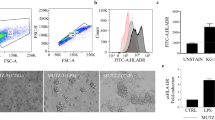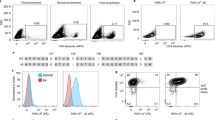Abstract
A crucial step in the immune response is the binding of antigenic peptides to major histocompatibility complex (MHC) proteins. Class II MHC proteins present their bound peptides to CD4+ T cells, thereby helping to activate both the humoral and the cellular arms of the adaptive immune response. Peptide loading onto class II MHC proteins is regulated temporally, spatially and developmentally in antigen-presenting cells1. To help visualize these processes, we have developed a series of novel fluorogenic probes that incorporate the environment-sensitive amino acid analogs 6-N,N-dimethylamino-2-3-naphthalimidoalanine and 4-N,N-dimethylaminophthalimidoalanine. Upon binding to class II MHC proteins these fluorophores show large changes in emission spectra, quantum yield and fluorescence lifetime. Peptides incorporating these fluorophores bind specifically to class II MHC proteins on antigen-presenting cells and can be used to follow peptide binding in vivo. Using these probes we have tracked a developmentally regulated cell-surface peptide-binding activity in primary human monocyte-derived dendritic cells.
This is a preview of subscription content, access via your institution
Access options
Subscribe to this journal
Receive 12 print issues and online access
$259.00 per year
only $21.58 per issue
Buy this article
- Purchase on Springer Link
- Instant access to full article PDF
Prices may be subject to local taxes which are calculated during checkout





Similar content being viewed by others
References
Trombetta, E.S. & Mellman, I. Cell biology of antigen processing in vitro and in vivo. Annu. Rev. Immunol. 23, 975–1028 (2005).
McFarland, B.J. & Beeson, C. Binding interactions between peptides and proteins of the class II major histocompatibility complex. Med. Res. Rev. 22, 168–203 (2002).
Jardetzky, T.S. et al. Peptide binding to HLA-DR1: a peptide with most residues substituted to alanine retains MHC binding. EMBO J. 9, 1797–1803 (1990).
Sato, A.K. et al. Determinants of the peptide-induced conformational change in the human class II major histocompatibility complex protein HLA-DR1. J. Biol. Chem. 275, 2165–2173 (2000).
Stern, L.J. et al. Crystal structure of the human class II MHC protein HLA-DR1 complexed with an influenza virus peptide. Nature 368, 215–221 (1994).
Cohen, B.E. et al. Probing protein electrostatics with a synthetic fluorescent amino acid. Science 296, 1700–1703 (2002).
Nitz, M., Mezo, A.R., Ali, M.H. & Imperiali, B. Enantioselective synthesis and application of the highly fluorescent and environment-sensitive amino acid 6-(2-dimethylaminonaphthoyl) alanine (DANA). Chem. Commun. (Camb.) 1912–1913 (2002).
Vazquez, M.E., Rothman, D.M. & Imperiali, B. A new environment-sensitive fluorescent amino acid for Fmoc-based solid phase peptide synthesis. Org. Biomol. Chem. 2, 1965–1966 (2004).
Vazquez, M.E., Blanco, J.B. & Imperiali, B. Photophysics and biological applications of the environment-sensitive fluorophore 6-N,N-dimethylamino-2,3-naphthalimide. J. Am. Chem. Soc. 127, 1300–1306 (2005).
Chen, H. et al. [Aladan3]TIPP: a fluorescent δ-opioid antagonist with high δ-receptor binding affinity and δ selectivity. Biopolymers 80, 325–331 (2005).
Saroja, G., Soujanya, T., Ramachandram, B. & Samanta, A. 4-Aminophthalimide derivatives as environment-sensitive probes. J. Fluoresc. 8, 405–410 (1998).
Hammer, J. et al. High-affinity binding of short peptides to major histocompatibility complex class II molecules by anchor combinations. Proc. Natl. Acad. Sci. USA 91, 4456–4460 (1994).
Roche, P.A. & Cresswell, P. High-affinity binding of an influenza hemagglutinin-derived peptide to purified HLA-DR. J. Immunol. 144, 1849–1856 (1990).
Denzin, L.K., Robbins, N.F., Carboy-Newcomb, C. & Cresswell, P. Assembly and intracellular transport of HLA-DM and correction of the class II antigen-processing defect in T2 cells. Immunity 1, 595–606 (1994).
Potolicchio, I. et al. Conformational variation of surface class II MHC proteins during myeloid dendritic cell differentiation accompanies structural changes in lysosomal MIIC. J. Immunol. 175, 4935–4947 (2005).
Pierre, P. & Mellman, I. Developmental regulation of invariant chain proteolysis controls MHC class II trafficking in mouse dendritic cells. Cell 93, 1135–1145 (1998).
Turley, S.J. et al. Transport of peptide-MHC class II complexes in developing dendritic cells. Science 288, 522–527 (2000).
Inaba, K. et al. The formation of immunogenic major histocompatibility complex class II-peptide ligands in lysosomal compartments of dendritic cells is regulated by inflammatory stimuli. J. Exp. Med. 191, 927–936 (2000).
Cella, M., Engering, A., Pinet, V., Pieters, J. & Lanzavecchia, A. Inflammatory stimuli induce accumulation of MHC class II complexes on dendritic cells. Nature 388, 782–787 (1997).
Colledge, L., Bennett, C.L., Reay, P.A. & Blackburn, C.C. Rapid constitutive generation of a specific peptide-MHC class II complex from intact exogenous protein in immature murine dendritic cells. Eur. J. Immunol. 32, 3246–3255 (2002).
Veeraswamy, R.K., Cella, M., Colonna, M. & Unanue, E.R. Dendritic cells process and present antigens across a range of maturation states. J. Immunol. 170, 5367–5372 (2003).
Wilson, N.S., El-Sukkari, D. & Villadangos, J.A. Dendritic cells constitutively present self antigens in their immature state in vivo and regulate antigen presentation by controlling the rates of MHC class II synthesis and endocytosis. Blood 103, 2187–2195 (2004).
Southwood, S. et al. Several common HLA-DR types share largely overlapping peptide binding repertoires. J. Immunol. 160, 3363–3373 (1998).
Vazquez, M.E., Nitz, M., Stehn, J., Yaffe, M.B. & Imperiali, B. Fluorescent caged phosphoserine peptides as probes to investigate phosphorylation-dependent protein associations. J. Am. Chem. Soc. 125, 10150–10151 (2003).
Vazquez, M.E. et al. 6-N,N-dimethylamino-2,3-naphthalimide: a new environment-sensitive fluorescent probe in δ- and μ-selective opioid peptides. J. Med. Chem. 49, 3653–3658 (2006).
Stern, L.J. & Wiley, D.C. The human class II MHC protein HLA-DR1 assembles as empty α β heterodimers in the absence of antigenic peptide. Cell 68, 465–477 (1992).
Riberdy, J.M. & Cresswell, P. The antigen-processing mutant T2 suggests a role for MHC-linked genes in class II antigen presentation. J. Immunol. 148, 2586–2590 (1992).
Alberti, S., Parks, D.R. & Herzenberg, L.A. A single laser method for subtraction of cell autofluorescence in flow cytometry. Cytometry 8, 114–119 (1987).
Parks, D.R., Roederer, M. & Moore, W.A. A new “Logicle” display method avoids deceptive effects of logarithmic scaling for low signals and compensated data. Cytometry A 69, 541–551 (2006).
DeLano, W.L. The PyMOL Molecular Graphics System (DeLano Scientific, San Carlos, California, USA, 2002).
Acknowledgements
We would like to thank M. Calvo-Calle for performing T-cell activation assays, R. Konz for assistance with flow cytometry experimentation and data interpretation, E. Lukovic and C. Painter for peptide synthesis, I. Strug for characterization of eluted peptides, E. Schreiter and Z. Zavala-Ruiz for helpful discussions, L. Lu for preparation of HLA-DR, J. Bill for the HA1.7 hybridoma, and the staff at the National Synchrotron Light Source (NSLS). Diffraction data for this study were measured at beamline X25 of the NSLS, support for which comes principally from the Office of Biological and Environmental Research and the Office of Basic Energy Sciences of the US Department of Energy, and from the National Center for Research Resources of the US National Institutes of Health. This work was supported by NIH-AI38996 (L.J.S.) and NSF CHE-0414243 (B.I.).
Author information
Authors and Affiliations
Contributions
P.V. performed the biochemical, cellular and spectroscopic studies, M.S. synthesized the fluorogenic amino acids and performed the chemical stability studies, T.N. determined the crystal structure, O.B. and S.C. performed biophysical and immunological assays, and P.V., M.S., B.I. and L.J.S wrote the manuscript.
Corresponding authors
Ethics declarations
Competing interests
There is a patent application pending (filed 13 April 2005) for the environment-sensitive amino acids originally introduced in J. Am. Chem. Soc. 127, 1300–1306 (2005).
Supplementary information
Supplementary Fig. 1
Absorbance and fluorescence spectra. (PDF 149 kb)
Supplementary Fig. 2
Peptide binding takes place primarily on the cell surface. (PDF 83 kb)
Supplementary Fig. 3
Open forms of (4-DAPA) and (4-DMNA) peptides. (PDF 267 kb)
Supplementary Table 1
Binding affinity of fluorogenic peptides. (PDF 27 kb)
Supplementary Table 2
(6-DMNA)-RSMA4L fluorescence intensity in different solvents. (PDF 44 kb)
Supplementary Table 3
Fluorescence lifetimes for free and DR-bound peptides. (PDF 74 kb)
Supplementary Table 4
Data collection and refinement statistics (molecular replacement). (PDF 71 kb)
Supplementary Methods
Preparation and analysis of ring-open forms; crystal structure; MHC-peptide binding assay; T-cell activation; fluorescence lifetime measurement. (PDF 60 kb)
Rights and permissions
About this article
Cite this article
Venkatraman, P., Nguyen, T., Sainlos, M. et al. Fluorogenic probes for monitoring peptide binding to class II MHC proteins in living cells. Nat Chem Biol 3, 222–228 (2007). https://doi.org/10.1038/nchembio868
Received:
Accepted:
Published:
Issue Date:
DOI: https://doi.org/10.1038/nchembio868
This article is cited by
-
A fluorogenic probe for predicting treatment response in non-small cell lung cancer with EGFR-activating mutations
Nature Communications (2022)
-
The Journey of 1-Keto-1,2,3,4-Tetrahydrocarbazole Based Fluorophores: From Inception to Implementation
Journal of Fluorescence (2022)
-
Fluorescent amino acids as versatile building blocks for chemical biology
Nature Reviews Chemistry (2020)
-
Preparation of a Trp-BODIPY fluorogenic amino acid to label peptides for enhanced live-cell fluorescence imaging
Nature Protocols (2017)
-
Far-red/near-infrared fluorescence light-up probes for specific in vitro and in vivo imaging of a tumour-related protein
Scientific Reports (2016)



